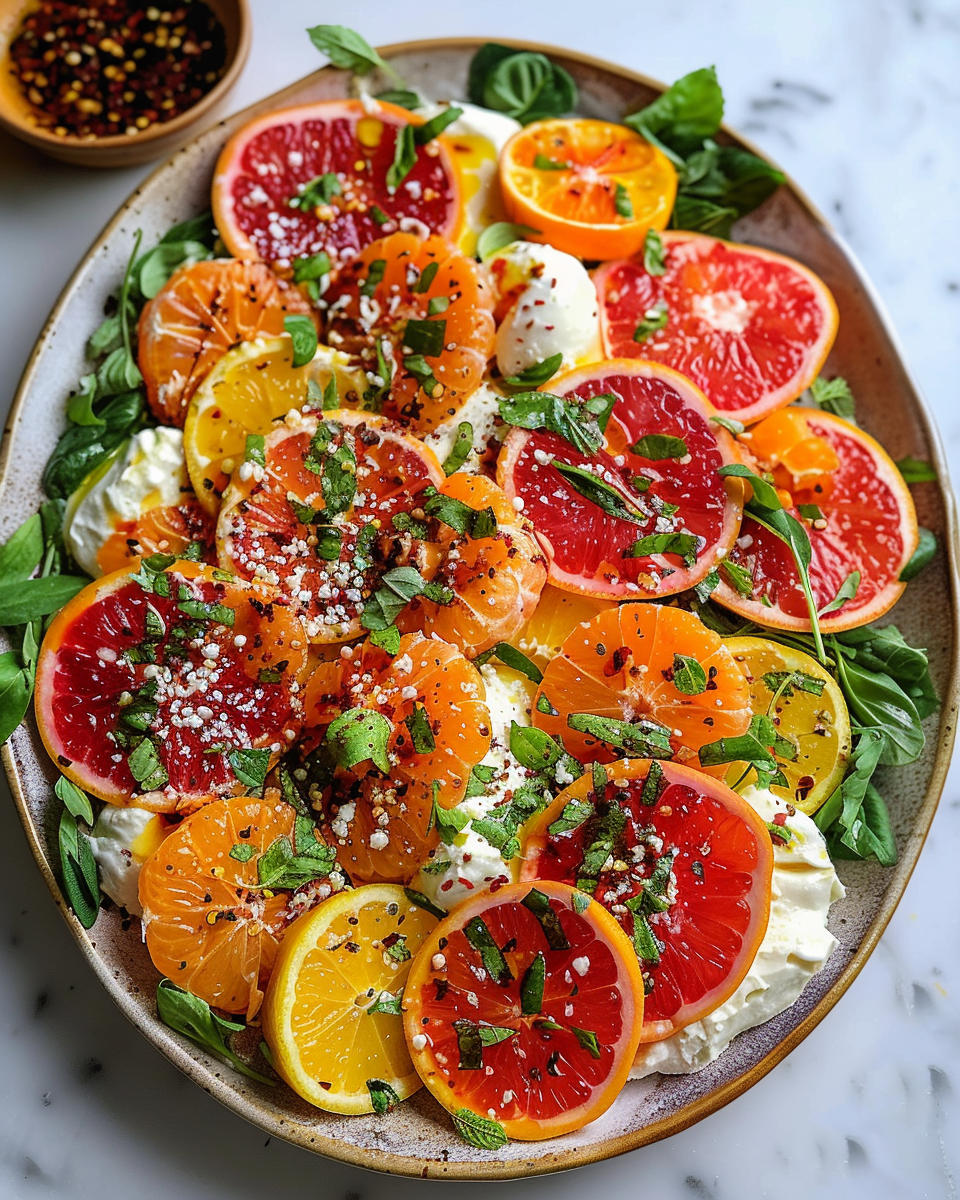Citrus Burrata Salad is a vibrant and refreshing dish that combines the creamy richness of burrata cheese with a medley of citrus fruits. It’s a perfect balance of sweet and tangy flavors, enhanced by fresh greens and crunchy toppings like pomegranate arils and chopped pistachios. This salad is an excellent choice for those seeking a light yet satisfying meal that can be enjoyed year-round.
In this article, we’ll dive into the unique aspects of Citrus Burrata Salad, covering everything from the essential ingredients to step-by-step preparation. We’ll also explore variations and serving suggestions, along with some FAQs to guide you through the process of making this delightful dish. Let’s start by examining what makes Citrus Burrata Salad stand out and why it’s becoming a popular choice among food enthusiasts.
What Makes Citrus Burrata Salad Unique?
Citrus Burrata Salad is a refreshing combination of creamy burrata cheese and a variety of citrus fruits. The unique aspect of this salad lies in its contrast of textures and flavors. The burrata, with its soft and creamy interior, complements the bright and zesty citrus slices. This combination creates a salad that’s both indulgent and light, making it ideal for various occasions.
The citrus fruits used in the salad can vary depending on what’s in season. Common choices include grapefruits, cara cara oranges, blood oranges, and clementines. These fruits not only add vibrant colors to the dish but also bring a range of flavors, from sweet to slightly bitter.
Burrata cheese, the star of the salad, is known for its creamy texture and mild flavor. It’s a type of fresh Italian cheese made from mozzarella and cream, with a soft center that pairs beautifully with the citrus fruits. The cheese adds a luxurious touch to the salad, making it suitable for both casual meals and special occasions.
The salad is typically served on a bed of fresh greens, such as arugula, baby kale, or spinach. These greens provide a peppery and earthy base that balances the sweetness of the citrus and the creaminess of the burrata. Additional toppings like pomegranate arils and chopped pistachios add crunch and visual appeal.
With this unique combination of ingredients, Citrus Burrata Salad offers a delightful culinary experience. It’s versatile enough to be served as a light lunch, a side dish, or even as an appetizer for a dinner party. Now that you understand what makes this salad special, let’s move on to the essential ingredients you’ll need to create it at home. In the next part, we’ll list the key components and discuss their roles in the salad’s overall flavor and texture. Stay tuned!
Print
Citrus Burrata Salad
Description
Arugula, burrata, and a bevy of sliced citrus team up for a delicious, no-fuss salad. We topped it with pomegranate arils and pistachio for a little crunch, then drizzled balsamic on top.
Ingredients
Instructions
Essential Ingredients for Citrus Burrata Salad
To create a delicious Citrus Burrata Salad, you’ll need a selection of fresh ingredients that bring together a harmonious mix of flavors and textures. In this part, we’ll list the essential ingredients required for the salad and explain their roles in achieving the perfect balance of sweet, tangy, and creamy. Let’s dive into what you’ll need to make this vibrant dish.
Core Ingredients
The core ingredients for Citrus Burrata Salad are a blend of citrus fruits, burrata cheese, and fresh greens. Here’s a detailed list:
- Burrata Cheese: Burrata is a fresh Italian cheese known for its creamy texture. It has a soft center, making it ideal for salads where it can be torn into smaller pieces. For this salad, you’ll need about 8 ounces of burrata.
- Citrus Fruits: A variety of citrus fruits provides the salad with a burst of color and a refreshing taste. You’ll need:
- 1 grapefruit
- 2 cara cara or navel oranges
- 3 small or 2 large blood oranges
- 3-4 clementines or tangerines These citrus fruits offer a mix of sweetness and tanginess, with a range of vibrant colors that add visual appeal to the salad.
- Fresh Greens: A base of fresh greens, like arugula, baby kale, or spinach, adds a peppery and earthy component to the salad. Use about 5 ounces, which is typically one small box.
Additional Toppings and Seasonings
To enhance the salad’s flavor and texture, you’ll need some additional toppings and seasonings:
- Pomegranate Arils: These add a pop of color and a sweet, juicy crunch. You’ll need about 1/3 cup.
- Finely Chopped Pistachios: These nuts bring a crunchy texture and a nutty flavor. Use about 1/4 cup.
- Finely Chopped Mint: Fresh mint adds a refreshing herbal note to the salad. You’ll need 2 tablespoons.
- Olive Oil: A generous drizzle of high-quality olive oil adds richness and helps to bring all the flavors together.
- Pomegranate Molasses or Balsamic Glaze: These can be used to add a touch of sweetness and a hint of acidity. Either will work, so choose your preference.
- Salt & Pepper: Season the salad with salt and pepper to taste, adding just enough to enhance the flavors without overpowering them.
With these essential ingredients, you’re ready to start preparing your Citrus Burrata Salad. In the next part, we’ll guide you through the step-by-step instructions for slicing the citrus, assembling the salad, and creating the dressing. Keep reading to learn how to bring these components together to make a delightful and refreshing salad.
Step-by-Step Instructions for Preparing Citrus Burrata Salad
With your ingredients ready, it’s time to start preparing your Citrus Burrata Salad. This part will guide you through the step-by-step process for slicing the citrus, assembling the salad, and creating the dressing. Follow these instructions to ensure your salad turns out fresh, vibrant, and delicious.
Step 1: Preparing the Citrus Fruits
The key to a successful Citrus Burrata Salad is properly preparing the citrus fruits. Here’s how to do it:
- Slice Off the Ends: Start by slicing off both ends of each citrus fruit, creating a flat surface for stability.
- Remove the Peel and Pith: Place the fruit on one of its flat ends and use a sharp knife to cut downward, removing the peel and white pith. Follow the fruit’s natural curve to avoid cutting too much flesh.
- Cut into Rounds: Once the peel and pith are removed, slice the fruit into thin rounds, about 1/4 inch thick. This creates attractive slices that showcase the vibrant colors of the citrus.
Repeat this process for each type of citrus fruit—grapefruit, cara cara or navel oranges, blood oranges, and clementines or tangerines. Keep the slices separate to make assembly easier.
Step 2: Assembling the Salad
With the citrus prepared, it’s time to assemble the salad. Follow these steps for a well-balanced and visually appealing salad:
- Layer the Greens: Begin by placing the fresh greens (arugula, baby kale, or spinach) on a large serving platter. Spread them evenly to create a base for the other ingredients.
- Add the Citrus Slices: Arrange the citrus slices over the greens in an aesthetically pleasing pattern. You can alternate the different types of citrus for a colorful display.
- Add the Burrata: Tear the burrata into smaller pieces and scatter them across the salad. Make sure to spread it out evenly so that each section has some cheese.
- Add the Toppings: Sprinkle the pomegranate arils, chopped pistachios, and finely chopped mint over the salad. These toppings add color, texture, and a touch of freshness.
Step 3: Dressing and Seasoning
To bring the salad together, you’ll need to add a dressing and season it properly. Here’s how to do it:
- Drizzle with Olive Oil: Generously drizzle high-quality olive oil over the salad. This adds richness and helps to combine the flavors.
- Add Pomegranate Molasses or Balsamic Glaze: Drizzle pomegranate molasses or balsamic glaze for a touch of sweetness and acidity. This step enhances the citrus flavors.
- Season with Salt and Pepper: Finally, season the salad with salt and pepper to taste. Be careful not to overdo it—just enough to enhance the flavors.
Once your Citrus Burrata Salad is assembled, dressed, and seasoned, it’s ready to serve. In the next part, we’ll explore some variations and customizations to add a unique twist to the salad. Keep reading to discover new ways to enjoy this delightful dish!

